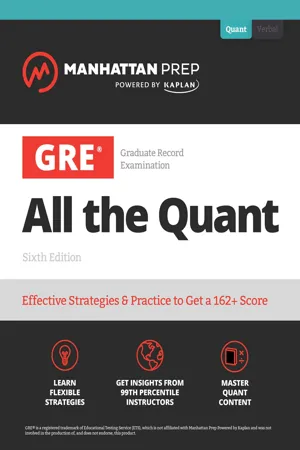Mathematics
Solving Radical Inequalities
Solving radical inequalities involves finding the values of a variable that satisfy an inequality containing radicals. To solve these inequalities, one typically isolates the radical expression, squares both sides of the inequality, and then solves for the variable. It's important to check the solutions obtained to ensure they are valid for the original inequality.
Written by Perlego with AI-assistance
Related key terms
Related key terms
1 of 4
Related key terms
1 of 3
5 Key excerpts on "Solving Radical Inequalities"
- eBook - ePub
GRE All the Quant
Effective Strategies & Practice from 99th Percentile Instructors
- (Author)
- 2023(Publication Date)
- Manhattan Prep(Publisher)
true statement.However, while equations on the GRE tend to have only one or two values as solutions, inequalities give a whole range of values as solutions—way too many to list individually.Here’s a comparison to illustrate:Equation Inequality x + 3 = 8−3 −3x = 5 x + 3 < 8−3 −3x < 5 In the equation, there’s just one solution: x must be 5. If you tried to substitute any number other than 5 for x into the equation you would get a nonsensical answer. For example, 2 + 3 does not equal 8.However, there are many different numbers that would make the inequality true—as long as those values are less than 5. Here are just a few possible values of x for the inequality:
Because inequalities tend to have many possible solutions, this topic is commonly tested in the Select All That Apply format.Is this true? Check the math: x + 3 < 8 ? Outcome x = 2 True, so 2 is a valid solution. x = −7 True, so −7 is a valid solution. x = 6 False, so 6 is not a valid solution. Check Your Skills
- Which of the following values of x are solutions to the inequality x < 10 ?
Indicate all such values.−32.59.999
Answers can be found on page 189.Simplifying Inequalities
Many of the rules you learned with respect to equations will still apply to inequalities; you’ll learn about the few exceptions in this chapter. The rules of PEMDAS apply, and whatever you do to one side of the inequality you must still do to the other side. The goal of isolating a variable remains the same:The inequalities 2x + 6 < 12 and x < 3 provide the same information, but the second inequality is much easier to understand.Simplifying via Addition and Subtraction
With equations, if you add the same number to both sides, the equation is still true. The same principle holds true for inequalities. If you add or subtract the same number from both sides, that inequality remains true: - eBook - ePub
- Leonard Dickson(Author)
- 2014(Publication Date)
- Dover Publications(Publisher)
VII . One of our chief aims is to decide whether or not every equation of the fifth or higher degree is solvable by radicals.The above definition permits the use of the operation of finding one of the pth roots of a quantity previously determined, but not the use of the operations of finding all its pth roots. The use of the latter operations would imply a knowledge of all the pth roots of unity, whereas one of our aims is to prove that, when p is a prime, they are all expressible in terms of radicals whose indices are < p.The solution of an equation solvable by radicals is usually accomplished by the solution of a series of auxiliary equations the roots of any one of which can be found by rational operations and root extractions performed upon its coefficients and the coefficients and roots of the preceding equations of the series. In order to focus our attention upon a particular equation of the series and to have a flexible phraseology, it will prove convenient to employ the following generalization of the foregoing definition of solvability by radicals.An equation with coefficients in a field R(k1 , … , km ) shall be said to be solvable by radicals relatively to that field if all of its roots can be found by rational operations and extractions of a root performed upon k1 , … , km or upon quantities derived from them by those operations.For example, x13 = 213 is evidently solvable relatively to R(ρ), where ρ is a particular imaginary 13th root of unity.97 .Resolvent equations. Let G be the group for a field F of a given equation f(x) = 0 with coefficients in F. A rational function ψ of the roots with coefficients in F belongs to a certain subgroup H of index u under G. By Theorem 9 of §91, ψ is a root of a resolvent equation of degree u with coefficients in F. Assume that this equation is solvable by radicals relatively to F. By adjoining its root ψ to F, we obtain a field F1 = F(ψ) for which the group of f(x) = 0 is now H(§92). Assume that successive such adjunctions lead to a field Fk for which the group of f(x) = 0 is the identity. Then the roots all belong to Fk - Boris Pritsker(Author)
- 2023(Publication Date)
- Chapman and Hall/CRC(Publisher)
9 Inequalities WonderlandDOI: 10.1201/9781003359500-9Mathematics is the tool specially suited for dealing with abstract concepts of any kind and there is no limit to its power in this field.Paul DiracInequalities are very important and are broadly used in all branches of mathematics. Learning about them paves the way to a deeper understanding of various topics in algebra, calculus, geometry, and number theory.Solving problems concerning inequalities involve immensely different techniques than solving equations. This is like operating in a different universe. In most cases, you are not required to find a specific value, but rather the range of values satisfying an inequality. To prove inequality holds true, one needs to determine a technique allowing one to verify the validity of a statement in question satisfying restrictions imposed on variables. We will go over several such techniques and reveal useful tricks in dealing with inequalities proofs. In this chapter, we will also show how inequalities can be applied (sometimes, unexpectedly) to solving many interesting problems that originally have nothing to do with inequalities. We will demonstrate how crucial it is to properly utilize them in revealing valuable connections between math disciplines and taking advantage of those connections for making solutions to complicated problems not just manageable, but efficient and elegant.One of the well-known classic inequalities that prove useful whenever we try to compare the numerical expressions or assess their upper or lower bounds is AM-GM Inequality introduced and frequently referred to in previous chapters:The arithmetic mean of any n nonnegative real numbers is greater than or equal to their geometric mean. The two means are equal if and only if all the numbers are equal:PROBLEM 9.1.≥na 1+a 2+ … +a n.na 1·a 2· … ·a nWhich one is the greater of two numbersa =or25 3+9 3b =?14350 6SOLUTION.Applying AM-GM Inequality to evaluate a, givesa =25 3+9 3≥ 2 ⋅=25 ⋅ 96=64 ⋅ 25 ⋅ 9614400 6>14350 6- eBook - ePub
Train Your Brain
Challenging Yet Elementary Mathematics
- Bogumil Kaminski, Pawel Pralat(Authors)
- 2020(Publication Date)
- Chapman and Hall/CRC(Publisher)
Chapter 2Equalities and Sequences
DOI: 10.1201/9781003097983-3As usual, we start the chapter with some basic definitions.- 2.1 Combining Equalities
- 2.2 Extremal Values
- 2.3 Solving via Inequalities
- 2.4 Trigonometric Identities
- 2.5 Number of Solutions
- 2.6 Sequence Invariants
- 2.7 Solving Sequences
THEORYSuppose that you are given an equation or a set of equations involving some number of variables. A natural question that is usually asked is to find a solution in some given domain. In general, there are the following three possible cases:- no feasible solution exits,
- there exists a unique solution,
- there are multiple solutions (the number of them could be finite or infinite).
For example, consider a quadratic equation, where= 0a +x 2b x+ ca ≠ 0. Our goal is to find all real solutions, that is, all values ofx ∈ Rthat satisfy this equation. After multiplying both sides by4 a, one can re-write it as follows:.=(2)2 a x- bb 2-4 a cIt is now clear that ifAnother important distinction is with respect to the number of equations. The problem we need to deal with could consist of, then the equation has no real solutions, as the left hand side is non-negative. On the other hand, if< 0b 2-4 a c, then the equation has exactly one solution, namely,= 0b 2-4 a cx =. Finally, ifb /(2 a), then we get two different solutions:> 0b 2-4 a candx 1=(/b +)b 2-4 a c(2 a). Let us mention that the valuex 2=(/b +)b 2+4 a c(2 a), which allows deducing some properties of the roots without computing them, is called the discriminant and is often denoted as Δ .b 2-4 a c - eBook - ePub
- Steven J. Rosenberg(Author)
- 2021(Publication Date)
- Chapman and Hall/CRC(Publisher)
Solvability of Polynomial Equations by RadicalsDOI: 10.1201/9781003252139-2222.1 Radicals
In this chapter, we complete the original program of Evariste Galois, which aims to understand the solution of polynomial equations in a single variable x by means of formulas involving a combination of ordinary arithmetic and roots—square, cube, or higher. We will take our coefficients from a field F.We start at the beginning. A linear equationa x + b = 0 ,(22.1)to be truly linear, must havea ≠ 0; then the unique solution in the field F isA quadratic equationx = −(22.2)b a.has up to 2 distinct solutions, which are given by the quadratic formulaa(22.3)x 2+ b x + c = 0x =(22.4).− b ±b 2− 4 a c2 aAlready, some issues appear here. First, we have no definition for a “square root” of an element in a general field F. In fact, the only situation when a square root has an unambiguous interpretation for us occurs when we take the square root of a non-negative real number, which by convention is another non-negative real number. Second, while we do know how to interpret an integer multiplied by a field element (for instance, 2a meansa + a), we are in trouble in casechar ( F ) = 2, for then the denominator is 0. The latter problem is easy to side-step: we can take F to have characteristic different from 2.The first problem can be smoothed over in a natural way: we can say that a square root (not “the” square root!) of an elementα ∈ Fis an element ρ of some extension field K of F with the property that. An nth root can be defined similarly for any positive integer n. As the reader may be aware, the term “radical” is a synonym for “root.” This leads us to the following definitions.ρ 2= αDefinition 22.1.Let F be a field. An element ρ of an extension field of F is called a (simple) radical over F
Index pages curate the most relevant extracts from our library of academic textbooks. They’ve been created using an in-house natural language model (NLM), each adding context and meaning to key research topics.
Explore more topic indexes
Explore more topic indexes
1 of 6
Explore more topic indexes
1 of 4




